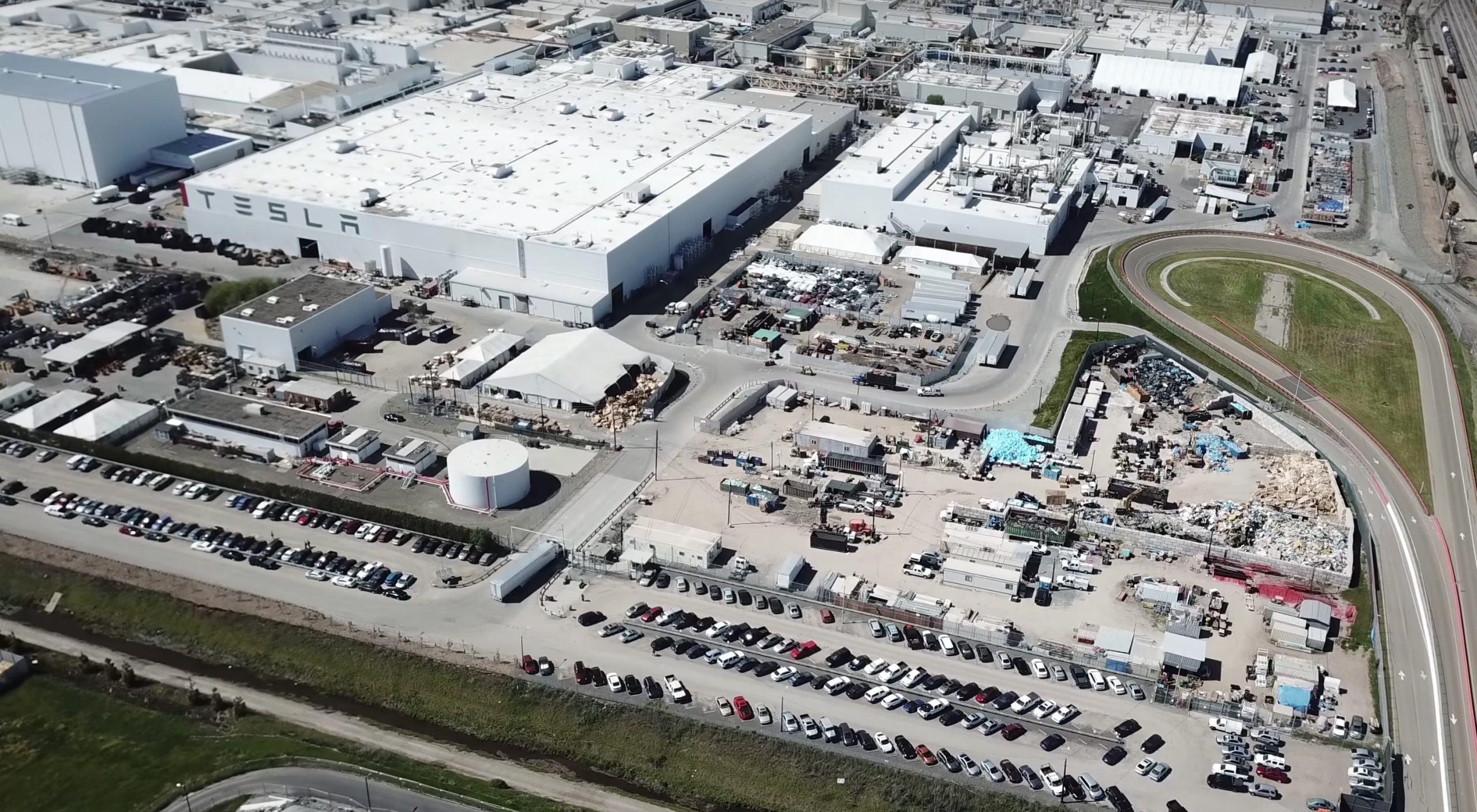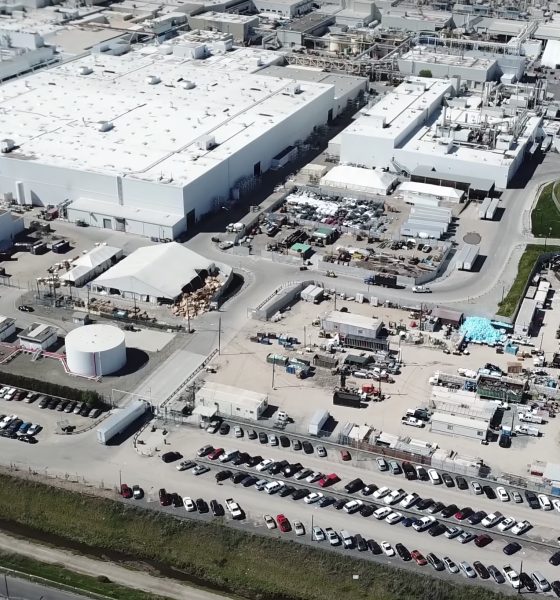

Investor's Corner
Tesla Fremont factory building permits reveal facilities and expansion costs
A compilation and analysis of building permits filed by Tesla since July 2016 has revealed that the Elon Musk-led company spent over $51.3 million in construction permits for the Fremont factory over the past two years. Tesla also invested more than $30 million in permits for nearby facilities, including its new offices located at Dumbarton Circle in Fremont’s Ardenwood District.
The breakdown of Tesla’s expenses in the development and continued improvement of the Fremont factory was compiled by BuildZoom, which sorted through the permits filed by the company using its National Building Permit Database. As could be seen in BuildZoom‘s findings, Tesla spared no expense when it came to ensuring that its main factory is optimized to tackle the immense challenge of producing the Model 3 at scale. Below is a table of Tesla’s expenses for the Fremont factory over the past two years. Do take note, however, that the expenses reflected do not account for the cost of robots and other equipment that Tesla purchased for each portion of the 370-acre site.
Over the past two years, Tesla had filed several building permits for Fremont that cost over $1 million, among these being a $4.5 million grading and foundation permit for a 104,324-square-foot North GA3 (General Assembly 3) building. Two permits, worth $4.2 million and $2 million, respectively, were listed as “capacity increases” to the North Paint building. Other noteworthy permits include a $1.2 million and $800,000 project for two new facilities — one of which being a sprung structure — as well as a $400,000 “Tesla Sunrise” road with bio-retention system at the factory’s Eastern boundary.
As a means to adapt to the mass number of Model 3 reservations it received, Tesla had filed roughly 100 industrial and commercial alteration permits for the Fremont factory since July 2016, costing a total of $16.2 million. Tesla also invested substantially in several key areas of the factory, including its body/assembly line, its paint shop, and its stamping building.
Tesla’s body and assembly building covers one of the largest areas in the Fremont factory. Since July 2016, Tesla spent more than $21.4 million (excluding the cost of machinery) on additions and improvements to the assembly and body area. Permits worth $14.2 million were also filed to develop infrastructure for GA3. Tesla’s stamping building, which houses one of the world’s 35 existing high-end Schuler servo stamping presses, has also seen $809,000 worth of improvements since July 2016. The location of these facilities could be viewed in the image below.
The electric car maker’s paint shops, both North and South, received $10.2 million worth of improvements since July 2016, including $240,000 spent on fire prevention systems like sprinklers, fire detectors, and other safety systems. Permits also reflected a $5.2 million investment on AFES (Automatic Fire Extinguishing System) for the factory.
Perhaps most interesting in Tesla’s permits, however, were filings referencing “Sprung” and “repack” tent structures that are worth $2.9 million. As revealed by Elon Musk recently, the largest of these tents is now the site of the Model 3’s newest assembly line, dubbed as GA4. Musk has been particularly optimistic about the tent-housed Model 3 line, stating on Twitter that it has a “slightly higher quality” than traditional assembly lines.
With the end of the second quarter just a few days away, Tesla is now working at a breakneck pace in its attempt to hit its all-elusive goal of producing 5,000 Model 3 per week by the end of Q2 2018. With Musk stating that GA4 is now working, and with sightings of lots filled with Model 3 being reported around the facility, it appears that Tesla is closer to its target than ever before.

Investor's Corner
Tesla stock closes at all-time high on heels of Robotaxi progress

Tesla stock (NASDAQ: TSLA) closed at an all-time high on Tuesday, jumping over 3 percent during the day and finishing at $489.88.
The price beats the previous record close, which was $479.86.
Shares have had a crazy year, dipping more than 40 percent from the start of the year. The stock then started to recover once again around late April, when its price started to climb back up from the low $200 level.
This week, Tesla started to climb toward its highest levels ever, as it was revealed on Sunday that the company was testing driverless Robotaxis in Austin. The spike in value pushed the company’s valuation to $1.63 trillion.
Tesla Robotaxi goes driverless as Musk confirms Safety Monitor removal testing
It is the seventh-most valuable company on the market currently, trailing Nvidia, Apple, Alphabet (Google), Microsoft, Amazon, and Meta.
Shares closed up $14.57 today, up over 3 percent.
The stock has gone through a lot this year, as previously mentioned. Shares tumbled in Q1 due to CEO Elon Musk’s involvement with the Department of Government Efficiency (DOGE), which pulled his attention away from his companies and left a major overhang on their valuations.
However, things started to rebound halfway through the year, and as the government started to phase out the $7,500 tax credit, demand spiked as consumers tried to take advantage of it.
Q3 deliveries were the highest in company history, and Tesla responded to the loss of the tax credit with the launch of the Model 3 and Model Y Standard.
Additionally, analysts have announced high expectations this week for the company on Wall Street as Robotaxi continues to be the focus. With autonomy within Tesla’s sights, things are moving in the direction of Robotaxi being a major catalyst for growth on the Street in the coming year.
Elon Musk
Tesla needs to come through on this one Robotaxi metric, analyst says
“We think the key focus from here will be how fast Tesla can scale driverless operations (including if Tesla’s approach to software/hardware allows it to scale significantly faster than competitors, as the company has argued), and on profitability.”

Tesla needs to come through on this one Robotaxi metric, Mark Delaney of Goldman Sachs says.
Tesla is in the process of rolling out its Robotaxi platform to areas outside of Austin and the California Bay Area. It has plans to launch in five additional cities, including Houston, Dallas, Miami, Las Vegas, and Phoenix.
However, the company’s expansion is not what the focus needs to be, according to Delaney. It’s the speed of deployment.
The analyst said:
“We think the key focus from here will be how fast Tesla can scale driverless operations (including if Tesla’s approach to software/hardware allows it to scale significantly faster than competitors, as the company has argued), and on profitability.”
Profitability will come as the Robotaxi fleet expands. Making that money will be dependent on when Tesla can initiate rides in more areas, giving more customers access to the program.
There are some additional things that the company needs to make happen ahead of the major Robotaxi expansion, one of those things is launching driverless rides in Austin, the first city in which it launched the program.
This week, Tesla started testing driverless Robotaxi rides in Austin, as two different Model Y units were spotted with no occupants, a huge step in the company’s plans for the ride-sharing platform.
Tesla Robotaxi goes driverless as Musk confirms Safety Monitor removal testing
CEO Elon Musk has been hoping to remove Safety Monitors from Robotaxis in Austin for several months, first mentioning the plan to have them out by the end of 2025 in September. He confirmed on Sunday that Tesla had officially removed vehicle occupants and started testing truly unsupervised rides.
Although Safety Monitors in Austin have been sitting in the passenger’s seat, they have still had the ability to override things in case of an emergency. After all, the ultimate goal was safety and avoiding any accidents or injuries.
Goldman Sachs reiterated its ‘Neutral’ rating and its $400 price target. Delaney said, “Tesla is making progress with its autonomous technology,” and recent developments make it evident that this is true.
Investor's Corner
Tesla gets bold Robotaxi prediction from Wall Street firm
Last week, Andrew Percoco took over Tesla analysis for Morgan Stanley from Adam Jonas, who covered the stock for years. Percoco seems to be less optimistic and bullish on Tesla shares, while still being fair and balanced in his analysis.

Tesla (NASDAQ: TSLA) received a bold Robotaxi prediction from Morgan Stanley, which anticipates a dramatic increase in the size of the company’s autonomous ride-hailing suite in the coming years.
Last week, Andrew Percoco took over Tesla analysis for Morgan Stanley from Adam Jonas, who covered the stock for years. Percoco seems to be less optimistic and bullish on Tesla shares, while still being fair and balanced in his analysis.
Percoco dug into the Robotaxi fleet and its expansion in the coming years in his latest note, released on Tuesday. The firm expects Tesla to increase the Robotaxi fleet size to 1,000 vehicles in 2026. However, that’s small-scale compared to what they expect from Tesla in a decade.
Tesla expands Robotaxi app access once again, this time on a global scale
By 2035, Morgan Stanley believes there will be one million Robotaxis on the road across multiple cities, a major jump and a considerable fleet size. We assume this means the fleet of vehicles Tesla will operate internally, and not including passenger-owned vehicles that could be added through software updates.
He also listed three specific catalysts that investors should pay attention to, as these will represent the company being on track to achieve its Robotaxi dreams:
- Opening Robotaxi to the public without a Safety Monitor. Timing is unclear, but it appears that Tesla is getting closer by the day.
- Improvement in safety metrics without the Safety Monitor. Tesla’s ability to improve its safety metrics as it scales miles driven without the Safety Monitor is imperative as it looks to scale in new states and cities in 2026.
- Cybercab start of production, targeted for April 2026. Tesla’s Cybercab is a purpose-built vehicle (no steering wheel or pedals, only two seats) that is expected to be produced through its state-of-the-art unboxed manufacturing process, offering further cost reductions and thus accelerating adoption over time.
Robotaxi stands to be one of Tesla’s most significant revenue contributors, especially as the company plans to continue expanding its ride-hailing service across the world in the coming years.
Its current deployment strategy is controlled and conservative to avoid any drastic and potentially program-ruining incidents.
So far, the program, which is active in Austin and the California Bay Area, has been widely successful.










